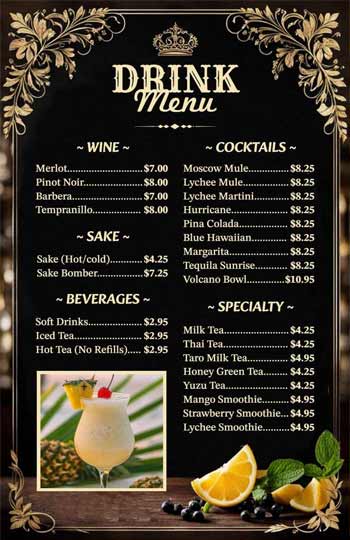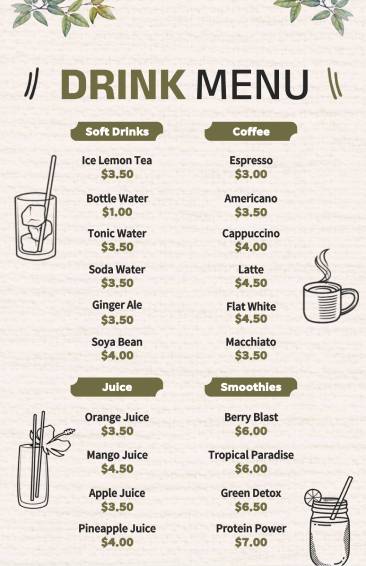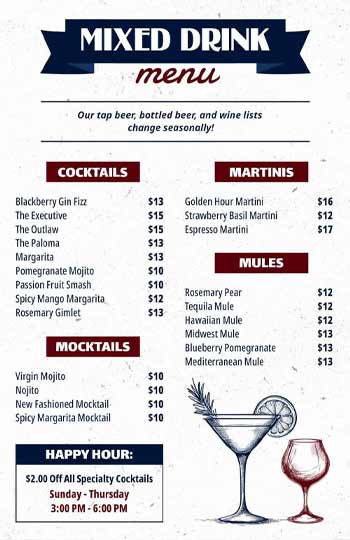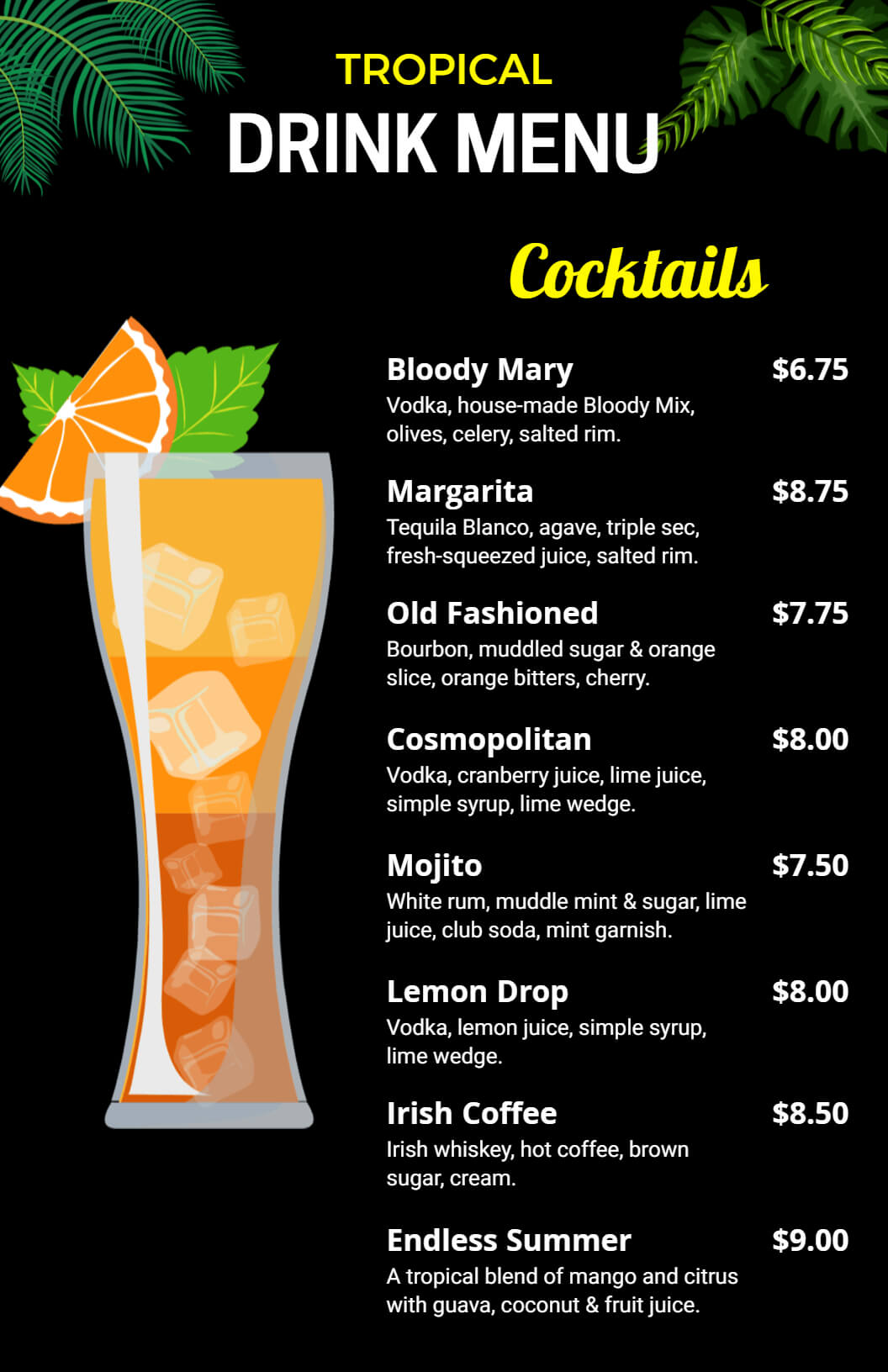Dig deeper and explore top drink menu templates that highlight your best beverages, guide choices, and enhance the overall dining experience.
Creating an effective drink menu becomes crucial for your business’s survival. Moreover, a well-designed beverage menu can increase your average order value by 20-30%.
Here you’ll unlock top ideas to make the drink menu design more appealing, and also get premade templates that you can easily customize.
What is the Meaning of the Drink Menu Template?
A “Drink Menu Template” is a pre-designed layout or structure that lists drinks or beverages offered by a restaurant, bar, cafe, or any establishment that serves drinks. The template shows the names of the drinks, their descriptions, and prices. It helps the business keep the menu consistent, attractive, and easy for customers to navigate.
You can also categorize the menu into different sections based on the type of drinks offered, such as alcoholic and non-alcoholic beverages, hot and cold drinks, or specialized drinks like smoothies, juices, cocktails, and mocktails. It often reflects the style, theme, or concept of the establishment.
A drink menu is a type of a la carte menu where each item is charged individually, and customers have the option to select items.
What are the Best Examples and Ideas of a Drink Menu?
When looking for cool drink menu examples for your bar, it’s important to focus on simplicity and visual flow. You can easily customize any menu template and create the best one that not only captures attention but also boosts your orders.






How to Design a Drink Menu for Maximum Impact?
Designing a drink menu isn’t just about listing your beverages—it’s about creating an experience that guides customers, tempts their senses, and encourages them to order more.
A thoughtfully designed drink menu can boost sales, highlight your brand, and make a lasting impression.
Here are the key secrets to designing a drink menu that delivers maximum impact:
1. Start with a Clear Structure
A well-crafted rink menu makes it easier for customers to find what they want. Divide the menu into clear categories such as non-alcoholic drinks, cocktails, wines, beers, mocktails, or hot beverages. This structure reduces decision fatigue and gives the menu a clean, readable flow. You can also arrange drinks by flavor (fruity, strong, sweet), by occasion (signature, light, after-dinner), or by popularity.
2. Use Visual Hierarchy to Guide Choices
Visual hierarchy is how you direct the customer’s eye to the most important items. Use larger fonts, bold text, or different colors to highlight your best-sellers or high-margin drinks. Place these options in key areas where eyes naturally fall, such as the top-right corner or the center of the page. This helps you subtly guide customers toward what you want them to order.
3. Write Descriptions that Tempt the Senses
A strong drink description can make a big difference. Use descriptive words that evoke taste, smell, and texture. Instead of saying “Mojito,” say “Refreshing Mojito with crushed mint, lime, and a splash of soda.” Sensory-rich language helps the customer imagine the drink, making them more likely to crave it. Write a good menu description, and ensure that it is easy to read, but full of flavor and emotion.
4. Use High-Quality Drink Images
Images can drive instant desire. Showcasing mouth-watering photos of drinks—especially colorful or signature items—can increase orders dramatically. Ensure the photos are realistic, professionally styled, and match what’s served. A frosty glass, fresh garnish, or bubbles can spark thirst at first glance. However, don’t overload the menu with images—use them sparingly for maximum effect.
5. Keep the Design Simple and On-Brand
Your menu should match your brand’s personality. A modern cafe might use clean fonts and minimalist layouts, while a tropical bar might use bold colors and playful designs. Stick to a consistent color scheme, font family, and design style throughout the menu. Keep the layout simple and clutter-free so it’s easy to scan, even quickly.
6. Add a Section for Seasonal or Limited-Time Drinks
Limited-time drinks create urgency and excitement. When customers see that a drink is available “only for summer” or “this week only,” they feel encouraged to try it right away. Seasonal menus also let you update the drink list throughout the year, keeping things fresh and giving regular customers something new to explore.
7. Use Pricing Psychology
The way prices are shown can influence buying decisions. Removing currency symbols softens the perception of cost. Also, using round numbers (like 250 instead of 249 or 255) looks cleaner and more premium. Placing a high-priced item next to mid-range options can make the mid-tier drink feel like a smart choice, gently boosting average spend.
8. Include Staff Picks or Popular Choices
Labeling certain drinks as “Staff Favorite,” “Most Ordered,” or “Customer Favorite” can build trust and guide indecisive customers. These tags act as social proof, making it easier for someone to choose a drink they feel confident they’ll enjoy.
9. Highlight Pairings or Suggestions
Help customers discover new flavor combinations by suggesting food pairings with certain drinks. For example, “Pairs well with spicy tacos” or “Perfect with chocolate cake.” These small cues encourage customers to explore and increase overall order value.
10. Make It Easy to Read on Any Format
Whether your drink menu is printed, digital, or viewed on a mobile screen, readability is key. Use readable fonts, plenty of spacing, and keep font sizes appropriate. If it’s a digital menu, make sure it loads quickly and is easy to scroll through. Accessibility and clarity improve the customer experience.
We’ve also covered a detailed guide on how to design a menu for drinks that leave lasting impression, and increase order value.
What Categories Should You Include in Your Drink Menu?
The organization of your drink menu directly affects customer behavior. Therefore, strategic placement and categorization become critical success factors. Moreover, the right structure guides customers toward higher-margin items naturally. Shipping. Kitchen, and glasses.
Essential Categories to Include:
- Signature Cocktails – Place these first to establish your brand identity. Furthermore, signature drinks command premium prices and create talking points for social media.
- Classic Cocktails – Include customer favorites to provide comfort and familiarity. Additionally, classics require less explanation and speed up service.
- Wine Selection – Organize by style rather than region for easier navigation. Moreover, include brief tasting notes to help customers make confident choices.
- Beer Options – List local and craft options prominently. Furthermore, seasonal rotations keep the menu fresh and encourage repeat visits.
- Non-Alcoholic Beverages – Don’t overlook this growing market segment. Additionally, creative mocktails can command a surprisingly high price.
What Makes a Drink Menu Different from a Food Menu?
Unlike food menus, drink menus face unique challenges and opportunities. Consequently, they require specialized strategies to maximize their effectiveness. Additionally, beverage preferences change more frequently than food trends, making adaptability essential.
Key Differences Include:
- Profit margins: Drinks offer 60-80% profit margins compared to 28-35% for food
- Seasonal variations: Beverage preferences shift dramatically with weather and holidays
- Emotional triggers: Drinks connect with mood, celebration, and social experiences
- Impulse purchases: Customers more readily add drinks to their orders
- Brand differentiation: Signature cocktails create memorable experiences
What Design Elements Make Customers Buy More Drinks?
Visual design significantly influences purchasing decisions. Therefore, every design choice should serve a strategic purpose. Moreover, professional presentation increases perceived value and customer confidence.
1. Color Psychology in Menu Design
Colors trigger emotional responses that affect buying behavior:
- Red: Creates urgency and stimulates appetite
- Blue: Suggests trust and reliability
- Green: Implies freshness and health
- Gold: Conveys luxury and premium quality
- Black: Represents sophistication and elegance
2. Typography That Sells
Choose fonts that match your brand personality. Additionally, ensure readability across all lighting conditions. Furthermore, use font weights to create visual hierarchy and guide attention.
Here is a checklist of typography that you must follow:
- Use a minimum 12-point font size for body text
- Ensure high contrast between text and background colors
- Test readability under your restaurant’s actual lighting conditions
- Keep bold text that draws attention to high-margin items and specials
- Use italic text to emphasize unique ingredients or preparation methods
Still confused? Read our guide on the best colors and typography for a menu to design a perfect menu for your restaurant.
3. Strategic Use of White Space
White space directs attention to important elements. Therefore, surround high-margin items with extra space. Moreover, avoid cluttered layouts that overwhelm customers.
Attention-Directing Techniques:
- Surround high-margin drinks with 2-3 times more white space than other items
- Use white space to separate premium sections from standard offerings
- Create visual breathing room around signature cocktails and featured wines
- Isolate call-out boxes containing seasonal specials or limited offers
Premium Positioning Through Space:
- Luxury brands use extensive white space to convey exclusivity
- Cramped layouts suggest value pricing and lower quality
- Adequate spacing between items reduces decision fatigue
- Clean layouts increase perceived professionalism and trustworthiness
4. Menu Size and Layout
Considering the menu layout that follows predictable eye-movement patterns. Therefore, understanding visual flow helps position profitable items strategically. Moreover, cultural reading patterns influence where customers look first and longest.
Customers typically scan menus in a triangle pattern – top right, top left, then center. Furthermore, this pattern holds true across different menu formats and orientations. Additionally, placing your most profitable drinks in these zones increases selection likelihood.
Strategic Item Placement:
- Top right corner: Highest-priced signature cocktails and premium wines
- Top left: Popular classics that build customer confidence
- Center: Featured seasonal drinks and promotional offers
- Bottom sections: Lower-margin items like beer and basic mixed drinks
5. Strategic Pricing
Pricing psychology is a subtle yet highly effective strategy used in menu design to influence customer behavior and encourage higher drink sales. It’s not just about setting a price—it’s about how that price is presented and perceived.
Note:- Studies show that prices without currency signs (e.g., “6” instead of “£6” or “$6”) reduce price sensitivity.
Another effective tactic is price anchoring—strategically placing a high-priced drink at the top of the menu to make mid-range options seem more reasonable. When customers see a $6 cocktail, they’re more likely to choose the $3 one, even if that’s still higher than what they originally intended to spend.
This not only increases average order value but also positions the mid-tier item as a “smart choice.”
6. Seasonal and Limited-Time Designs
Seasonal and limited-time drink designs are powerful tools that create excitement, urgency, and variety—key drivers of customer interest and increased sales.
Customers don’t want to miss out on something special, which often leads them to order seasonal beverages they might otherwise skip. This “fear of missing out” (FOMO) is a psychological motivator that can significantly boost drink sales, especially when highlighted effectively on the menu.
The language used in seasonal drink descriptions also plays a critical role. Words like “limited-time,” “only this season,” or “holiday exclusive” immediately signal rarity and value. Descriptions that evoke seasonal flavors—such as “pumpkin-spiced,” “berry-infused,” “cooling mint,” or “toasted caramel”—add to the sensory appeal.
Incorporating seasonal and limited-time designs into your drink menu isn’t just about offering variety—it’s about creating a moment.
7. Use Mouth-Watering Images of Dishes
Using high-quality, mouth-watering images of dishes is one of the most effective ways to influence customer choices and increase sales–especially when it comes to food and drink menus.
- Image quality and realism are essential – Photos should accurately reflect the dish the customer will receive.
- Images must look fresh and professionally styled – A polished presentation makes food more appealing.
- Avoid over-editing – Artificial or heavily edited images can lead to customer disappointment and reduce trust.
- Key visual elements matter – Lighting, angles, textures, and composition all influence how appetizing the food looks.
- Use natural lighting when possible – It brings out true colors and textures without looking overly staged or fake.
- Add subtle sensory cues – Details like steam rising from hot dishes or a glossy shine on desserts increase mouth-watering appeal.
- Visuals evoke taste and emotion – These elements trigger cravings in a way text alone cannot.
What Technology Can Optimize Your Drink Menu Performance?
Modern technology provides insights that transform drink menu performance. Therefore, data-driven decisions replace guesswork. Moreover, digital tools streamline operations and improve customer experiences.
Here are some key metrics you should track.
| Point-of-Sale Analytics | Digital Menu Boards | QR Code Menus |
|---|---|---|
| Sales velocity by drink category | Real-time updates for availability | Detailed descriptions without space constraints |
| Profit margins per item | Promotional highlighting for featured items | High-resolution images that sell drinks |
| Customer preferences by demographic | Visual appeal that encourages purchases | Easy updates for seasonal changes |
| Seasonal trends and patterns | Cost savings on printing and redesign | Contactless ordering for safety |
What Metrics Should You Track for Menu Success?
Data drives informed decisions about menu changes. Therefore, tracking the right metrics ensures continuous improvement. Moreover, regular analysis identifies opportunities for optimization.
Financial Performance Indicators
Monitor these key numbers:
- Revenue per available seat
- Average beverage check per customer
- Profit margin by drink category
- Food and beverage ratio balance
Operational Efficiency Metrics
Track these operational factors:
- Preparation time per drink
- Ingredient waste and spoilage
- Staff efficiency during peak periods
- Customer wait times for service
Customer Satisfaction Measures
- Gauge customer response through:
- Verbal feedback from service staff
- Online reviews mentioning drinks
- Social media engagement with beverage content
- Repeat customer ordering patterns
What Mistakes Should You Avoid While Creating Drink Menus?
Even experienced restaurant owners make critical errors that cost thousands in lost revenue. Therefore, understanding common pitfalls helps you avoid expensive mistakes. Moreover, learning from others’ failures saves time and money while accelerating your success.
Research indicates that 73% of restaurants lose potential revenue due to poorly designed drink menus. Furthermore, these drink menu design mistakes often go unnoticed for months or years, silently draining profits. Additionally, some errors drive customers away rather than attracting them.
1. Overloading the Menu with Too Many Options
Offering a wide variety of drinks may seem like a good idea, but too many choices can overwhelm customers. This leads to decision fatigue, where the customer becomes confused and may end up choosing something basic, or nothing at all.
A better approach is to offer a well-curated selection. Highlight your signature or best-selling drinks, and organize them into clear sections. This makes it easier for customers to make quick and satisfying choices.
2. Using Poor-Quality or No Images
One of the biggest missed opportunities in drink menus is the lack of visual appeal. A menu without images can feel dull, especially in today’s digital world. However, using low-quality, blurry, or fake-looking photos is even worse—it makes customers doubt the quality of the drinks.
3. No Mentioning Ingredients Properly
Descriptions should be short, tempting, and easy to read. Some menus use overly complex language, long ingredient lists, or confusing drink names that don’t help the customer understand what they’re ordering. Use sensory words like “refreshing,” “smooth,” or “zesty,” and highlight key ingredients.
4. Using Inconsistent Branding or Design
Your drink menu should reflect your overall brand. Using fonts, colors, or styles that don’t match your restaurant’s identity can confuse customers and make the experience feel disjointed. For example, a luxury bar should avoid using playful fonts or cartoon-like icons.
5. Overlooking Pricing Strategy
Pricing mistakes are common in drink menus. Some menus place too much focus on prices by aligning them in a column, which encourages customers to scan for the cheapest item. Others use inconsistent pricing formats, such as some prices with decimals and others without.
7. Failing to Highlight Signature Drinks
If you don’t guide customers toward your most popular or profitable drinks, they may skip them altogether. Highlight your staff picks, best-sellers, or seasonal favorites with small labels like “Most Popular,” “Bartender’s Choice,” or “Only for Summer.”
8. Not Updating the Menu Regularly
Menus that stay the same for too long become stale. If customers return and see no new drinks or seasonal specials, they lose excitement. Update your menu with fresh items at least every few months. Add limited-time options, highlight new creations, or rotate flavors based on seasons. A dynamic menu keeps your offering exciting and encourages repeat visits.
Avoiding these common mistakes is the first step to creating a drink menu that performs well and leaves a great impression. A successful drink menu is simple, organized, visually appealing, and aligned with your brand.
Why Does Seasonal Drink Menu Rotation Boost Revenue?
Seasonal changes create excitement and urgency. Therefore, rotating drink offerings encourages frequent visits. Moreover, seasonal ingredients often provide better profit margins and fresher flavors.
Spring Menu Strategies
Focus on fresh, light flavors that celebrate renewal:
- Floral cocktails with elderflower or lavender
- Citrus-forward drinks using seasonal fruits
- Herb-infused spirits featuring fresh mint or basil
- Sparkling cocktails that feel celebratory
Summer Profit Maximizers
Hot weather drives beverage sales naturally:
- Frozen cocktails with premium spirits
- Large-format drinks for sharing
- Refreshing mocktails for designated drivers
- Outdoor dining specials that encourage lingering
Fall and Winter Warmers
Comfort drinks command premium prices:
- Heated cocktails with seasonal spices
- Barrel-aged cocktails for sophistication
- Rich, creamy drinks that satisfy comfort cravings
Holiday-themed specials that create traditions
Drink Menu FAQs
1. What should I include in a drink menu?
A good drink menu should have different types of drinks like hot drinks (coffee, tea), cold drinks (sodas, juices), alcoholic drinks (if you serve them), and water. Include prices, drink sizes, and short descriptions. Group similar drinks together to make it easy for customers to find what they want. Don’t forget to list any special drinks that make your place unique.
2. How do I price drinks on my menu?
Look at what other similar places charge for drinks in your area. Think about how much the drinks cost you to make, plus your profit. Usually, drinks should cost 3-4 times what you pay for ingredients. For example, if a coffee costs you $1 to make, you might sell it for $3-4. Also, consider your location and target customers when setting prices.
3. What size should my drink menu be?
Common menu sizes include 8.5 x 11 inches (standard paper), 8.5 x 14 inches (legal size), or 11 x 17 inches (tabloid) for larger menus. Consider where customers will read the menu – table menus can be larger, while takeout menus should be smaller and easier to hold. Choose a size that fits your template and printing needs.
4. What information do customers need to see for each drink?
Include the drink name, price, and size. Add a short description if the drink isn’t common or if it’s special to your place. Mention important ingredients, especially for people with allergies. For alcoholic drinks, you might want to include alcohol content. Keep descriptions short but helpful.
5. How can I create a drink menu quickly?
To quickly create a menu not just for drinks, but restaurants, cafes, food trucks, and more, using an online menu maker app and editing software. Also, you can customize readymade templates like images, texts, description, price, colors, and more.
Conclusion
Remember, every customer interaction with your drink menu is a sales opportunity. Furthermore, the right approach turns casual diners into loyal customers who return for your unique beverage experience.
Start implementing these strategies today. Additionally, track your results and adjust based on customer response. Most importantly, view your drink menu as an investment in your restaurant’s future success.
By following these comprehensive guidelines, you’ll create a d
rink menu that not only satisfies customers but also maximizes your restaurant’s potential.

